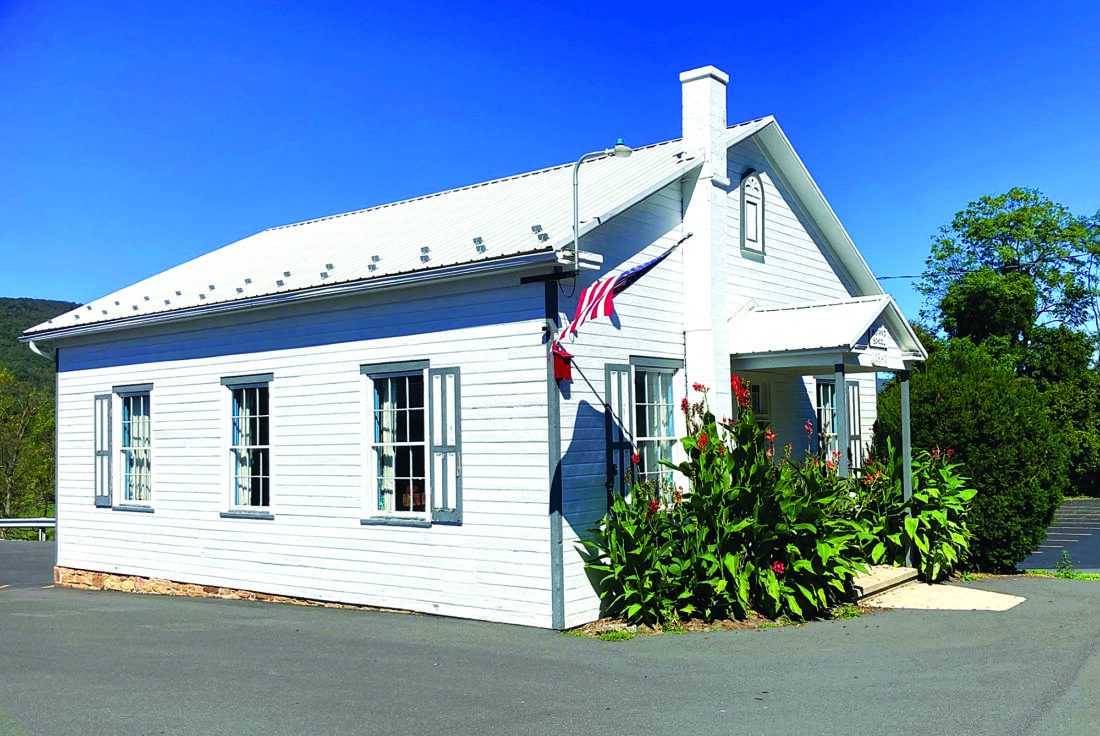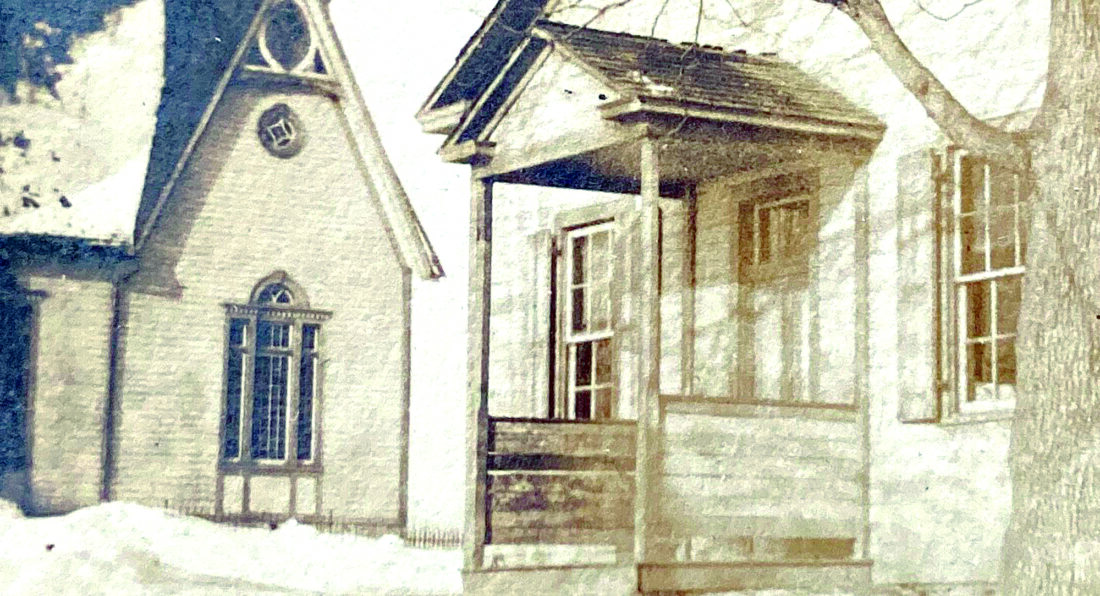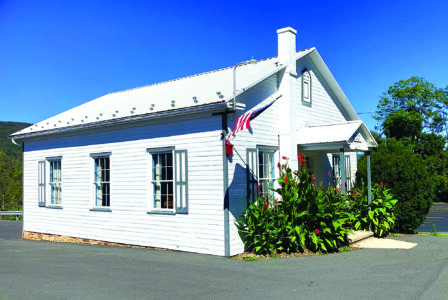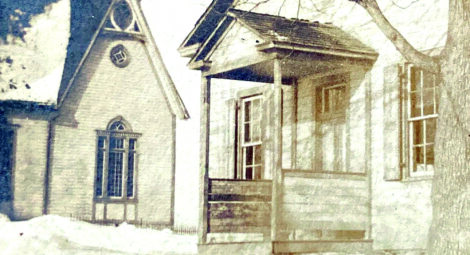The story of the Aurand School at Ellen Chapel
- Photo by FOREST FISHER The Aurand School in 2025.
- Photo courtesy AURAND SCHOOL COLLECTION The Aurand School (at right), Ellen Chapel Church (at left), circa 1920.

Photo by FOREST FISHER The Aurand School in 2025.
The story of the Aurand School, located beside Ellen Chapel in Ferguson Valley, began soon after the state of Pennsylvania passed the Common School Law in 1834.
Also known as the Free School Act, the new law went into effect the next year, 1835, mandating that each county in the Commonwealth must establish a school district in every township and borough.
Mifflin County originally had six school districts, but as new townships were created from the original ones, that number grew. The Aurand School would be part of Granville Township, which formed in 1838 from portions of Derry Township.
Granville Township School District operated many rural and village schools. Granville, Fairview, Strode’s Mills, Junction, Lake Park, Juniata Terrace, Hawstone plus rural schools west of Lewistown, on Ridge Road and throughout Ferguson Valley. Each was constructed from a variety of building materials, including logs, stone, bricks and wood frame.
Ferguson Valley had three schools in those early years: Tate School, McKee School and the Aurand School.

Photo courtesy AURAND SCHOOL COLLECTION The Aurand School (at right), Ellen Chapel Church (at left), circa 1920.
The Aurand School was established in 1840, according to both written and oral history collected over the years by Ellen Chapel.
In History of Mifflin County Schools by Elmer E. Sipe, 1950, published by the Mifflin County Historical Society, the original Aurand School was a stone building built adjacent to Ellen Chapel. A fire destroyed the building prior to the present structure, a frame building dating from 1840.
A school history compiled by former students notes that a stone footer in the earthen floor underneath points to that earlier structure.
That same oral history was compiled from the recollections of the late Lynn Aurand and Erma Aurand Bortell. In addition, Ron Aurand, though not an Aurand School alumni, but of that generation, is a current Ellen Chapel Church member and caretaker of Aurand School memorabilia.
The oral history explains when entering the school house, the tongue and groove boards on the interior walls have been paneled over. The cupboards in each corner were used for classroom storage. The chalkboards are still in place. The school was typical of a one room school during that era. It contained wooden desks that were bolted to the floor and arranged by size. The smaller desks were at the front of the room and occupied by first and second graders. The desk gradually increased in size ending with the seventh and eighth graders in the rear. There was a center aisle with two rows of seats to the right and left of the aisle.
A coal stove sat in the corner of the room, and the older students were in charge of keeping the coal buckets full of bituminous coal.
Students were also responsible for keeping the water buckets full during the day. Water was obtained at the nearby Kochenderfer farm’s spring house, located on a natural spring at the corner of Ferguson Valley Road and Sand Ridge Road.
Students attending school remember a bell of modest size located on top of the porch roof. It would be rung each morning signaling the beginning of a new school day, which began each morning at 9 a.m. and ended with dismissal at 4 p.m. The flag was raised each morning and was considered an honor when you were asked to raise the flag, according to the oral history of the school.
The usual subjects were taught, and when asked, Erma Bortell’s favorite subject was math. Lynn Aurand enjoyed all the subjects. Music was very important and was taught by Martha Snyder, piano teacher. Memorization was also important, especially when it came to the number facts and multiplication tables. Writing was difficult, especially for those who were left-handed. They were made to use their right hand! Every Friday a spelling bee was held. Successful scholars received a star to add to their reward book.
Recess included activities, like sled riding in the winter, playing baseball, marble games, hopscotch, and High Bucket Buck! (Where students on hands and knees tried to build a tower of student bodies until the pile collapsed).
Some school alumni recalled that if you were absent for more than three days in a row, the truant officer might be knocking at your parents’ door. One of the punishments for an infraction of the rules was to clean the chalkboard. While cleaning the chalkboard was a punishment, cleaning the erasers was considered to be fun. Especially fun if you didn’t get caught banging the erasers against the side of the school building or your friends head.
The Aurand School can be seen in all its vintage glory at age 185 on the Ellen Chapel property. The structure retains its color scheme, as remembered by those who attended in the pre-1940 years. All remember it as white, not the red usually associated with schools of its era. There is no public entrance to the building. However, located between the church and Eleanor’s Pavilion on Ellen Chapel property, a pleasurable drive by on a fall day allows travelers an exterior glimpse of what rural education looked like in Mifflin County. (The Mifflin County Historical Society’s Hoopes School and its interior is open to the public on special days throughout the year. Check media announcements).
The bell returns to Aurand School
Records indicate that the Aurand School closed in 1940-41. Other Granville Township rural schools in Ferguson Valley closed, too, as the era of one room schools was winding down, results of school consolidated.
Ellen Chapel Church acquired the school and grounds after it closed and utilized the building for Sunday School activities, 4-H meetings and general storage.
Many relics from the school’s active years remained in the building’s classroom and crawl space. An old weathervane, ink bottles, an iron plate from the old coal stove, coal buckets with coal, water buckets, and an old large tin container that once held lime to sanitize the school’s outhouse. These were rescued from the crawl space by Ron Aurand. These are occasionally displayed in the church during Aurand reunions.
A Kochenderfer family story recounts that at some point after the Aurand School closed, the old bell found its way from the crawl space to the nearby Harry and Grace Kochenderfer farm. With the efforts of their son Vincent and his buddy Louis Vogt, the bell rested with the Kochenderfer family until the 1960s.
Harry and Grace both died in 1963 and an auction soon followed. At this time the old Aurand School bell came into permanent possession of son Vincent and it travelled west to Michigan, Vincent’s and his family’s home. He died in 1998 and the bell remained with his Michigan family.
In recent years, the fate of the Aurand School bell was determined by Vincent’s descendants. It seemed fitting to return the bell to its home in Ferguson Valley. Vincent’s son Mark made the cross country journey with the bell, destined for a triumphant return.
Ellen Chapel was preparing to recognize church member Ethel Aurand Smith’s 100th birthday this past September. The occasion was an appropriate occasion to also welcome the Aurand School bell back to the school and the church.
Radio commentator Paul Harvey Aurandt, spelled with a final “t” is a relative of all the Ferguson Valley Aurands and their descendants. Paul had a classic closing to each recounted tale he would tell on radio. And for the Aurand School, to quote Paul Harvey, “Now you know the rest of the story.”




